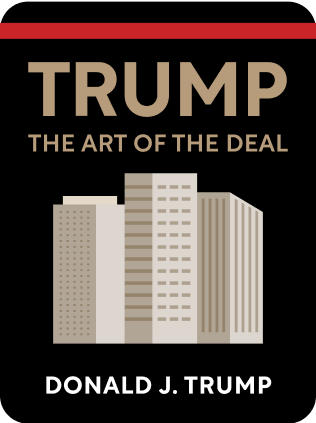

This article is an excerpt from the Shortform book guide to "The Art of the Deal" by Donald J. Trump. Shortform has the world's best summaries and analyses of books you should be reading.
Like this article? Sign up for a free trial here .
What are the 11 steps from The Art of the Deal? What can you learn from Donald Trump’s approach to business negotiation?
In 1987, Donald Trump wrote a book about 11 principles that have guided him through his business decisions. The 11 steps of The Art of the Deal encapsulate these principles in the context of Trump’s real estate projects.
Keep reading for Donald Trump’s The Art of the Deal 11 steps.
The Art of the Deal: 11 Steps to Business Success
Trump loves making deals. Profits motivate him, but the challenge and fun of deal-making drive him even more. Beyond his natural aptitude, he attributes his success to 11 steps in The Art of the Deal.
Principle #1: Aim High
The first of The Art of the Deal 11 steps is to aim high. Many people limit their goals because they’re afraid of making big decisions and, ultimately, afraid of success.
While his father built low- and middle-income housing in Brooklyn and Queens, Trump always had his sights set on more glamorous and profitable buildings in Manhattan.
In order to think—and achieve—big, you need total focus. Many successful business people possess a “controlled neurosis,” an obsessive drive and single-mindedness that they channel into their work.
Principle #2: Prepare for the Worst
No matter how optimistic you are about a deal, you have to be ready for the possibility that it will fall through. If you act conservatively and prepare for the worst-case scenario, you guarantee your success, even if it means settling for slightly less than you initially wanted.
In other words, if you swing for a home run every time you’re at bat, you’ll often strike out. But if you make the most of every pitch, you can make steady progress by getting to first, second, and third base.
While building a casino in Atlantic City, Trump delayed construction until his gaming license was approved, even though he had to pay carrying charges on the property in the meantime. He could’ve started construction while he waited for the license, but if he didn’t get approved then he’d have lost millions on the construction costs. Paying the carrying charges cost him a little more in the short term, but it was worth avoiding the risk of losing even more. (We’ll talk more about the Atlantic City project in Chapter 8).
Principle #3: Have a Backup Plan
Always have a plan B, plan C, and even plan D—and don’t get too attached to any one of them.
The majority of deals fall through, so your long-term success depends on your ability to be flexible and change course if need be. When you need to pivot to your backup plan, you won’t waste valuable time coming up with an alternative and figuring out how to approach it—you’ll have had it in mind the whole time.
Trump’s original plan when he bought a large undeveloped site in Manhattan was to build middle-income housing. But when the city’s public housing subsidies dissipated, he agilely shifted to his backup plan of building a convention center on the site. (More on the 34th Street convention center in Chapter 5.)
Principle #4: Know Your Target Audience
Successful people know their audiences. This is true for movie directors, authors, salespeople, and real estate developers. Anytime you’re creating or marketing some kind of product to other people, you need to know who you’re targeting, what they want, and how they think.
Trump believes that understanding your target audience is an instinct—and that he has it. This is why Trump seldom bases decisions on marketing surveys or consultants; instead, he asks people he trusts to gauge others’ opinions and ultimately goes with his gut.
By the same token, Trump doesn’t give much credence to critics. For example, critics didn’t like the size and design of Trump Tower (as we’ll discuss in Chapter 7), but Trump was confident it would appeal to his target audience of renters and shoppers.
Principle #5: Have a Bargaining Chip
There’s an inevitable power dynamic in deal-making: If you’re in a position of strength, you can push the other party to concede more. Sometimes circumstances naturally put you in the position of power—but sometimes you can gain power by making the other person think she has the power.
When you understand the other party’s perspective, wants, needs, and weaknesses, you can pitch the deal in a way that makes it seem like a win-win. You don’t have to ask for less, you just have to reframe it. You need to be creative, and you need to be able to sell it. Understanding your opposing party is just as important as understanding your audience.
For example, when Trump was pushing the New York City Planning Commission to approve his plans to renovate the Commodore Hotel, he got the Commodore’s owners to announce that the hotel would be closing. This helped him convince the city that it was in the city’s best interest to approve the plans and reopen the hotel rather than letting the building sit vacant and boarded up.
Principle #6: Buy Good and Make It Better
“Location, location, location” isn’t about buying the best location at a premium cost—it’s about getting a great deal on a location you can enhance through marketing and psychology.
To do this, you must recognize assets that you can play up. For example, a waterfront view gives a location great potential even if the neighborhood is in poor shape. Even if you don’t have the means to change the neighborhood, you can focus your marketing on the assets and create an image of a one-of-a-kind waterfront location.
If you market well and succeed in attracting influential, wealthy, and fashionable people, then you’ve already enhanced the location; presumably more change will follow. In other words, marketing makes a location appear more desirable, which leads to changes that actually make the location more desirable.
Principle #7: Promote
Be your own publicist. You know your product best, so spread the word about how great it is, because it doesn’t matter how good your product is if no one knows about it.
Promoting your work through the media is more economical than traditional marketing: It costs money to take out print or broadcast ads, but if the paper runs a story about your project it costs nothing. Plus, people are more likely to be skeptical of advertising than of a third-party report.
Don’t aim for negative press, but use it to your advantage if it occurs. Bad publicity brings more attention and, if you leverage it, that can help business.
Use and understand the press. The media wants a good story, and you can make a good story even better if you add an element of novelty, boldness, or controversy; Trump endorses what he calls “truthful hyperbole,” or harmless exaggeration. (Shortform note: Tony Schwartz, the book’s ghostwriter, has said that Trump justified lying by calling it “truthful hyperbole.”)
When you talk to the press, know the story you’re selling. Even if a reporter asks a tough question, you can always frame your answer positively. Promote yourself with enthusiasm and bravado that can infect others. Know your audience, including what they want to see and hear.
Principle #8: Fight If You Think You’re Right
The more successful you become, the more people will try to take you down out of envy and spite, so you have to stand up for yourself. Don’t be afraid to fight for what you think is right, even if it means offending some people in the process. You may not always win, but if you stand up for what you believe in, you give yourself a chance of winning, and you can feel confident that you did all you could.
Trump even fights when it costs him more than he may gain. He doesn’t necessarily recommend that everyone takes that approach, but he attributes it to his personality.
Principle #9: Have a Good Product
All the marketing and bravado in the world falls flat if you don’t have the substance to back it up. You may be able to fool people into believing you for a little while, but they’ll eventually catch on if you can’t deliver on your promises.
A strong product is the difference between appealing marketing and real success.
When Trump renovated the Commodore Hotel, he pushed the banks and the city to get on board by emphasizing that the hotel’s success would be critical to revitalizing the neighborhood and giving the city an economic boost. He was still a novice developer, and he knew his credibility depended on executing the project well to deliver on his promises.
Principle #10: Keep Costs Low
Don’t hesitate to spend money when things are worth the expense and truly add value to your work, but never spend more than you have to.
Trump challenges contractors when he feels they’re overcharging him even $5,000—in a multimillion-dollar project, this is pennies. But pinch enough pennies and they’ll add up to dollars in your pocket.
Principle #11: Enjoy the Ride
Finally, the last (but not least) of The Art of the Deal 11 steps is to focus on the process and not the material gain. The money is an undeniable bonus, but the pleasure comes in the sport and the art of deal-making. Don’t worry too much about what’s in the past or future—just enjoy the present.

———End of Preview———
Like what you just read? Read the rest of the world's best book summary and analysis of Donald J. Trump's "The Art of the Deal" at Shortform .
Here's what you'll find in our full The Art of the Deal summary :
- What Donald Trump says about his early life before the White House
- The 11 principles Trump says guided his business decisions
- How the West Side rail yards project proved to be a challenge for Trump






